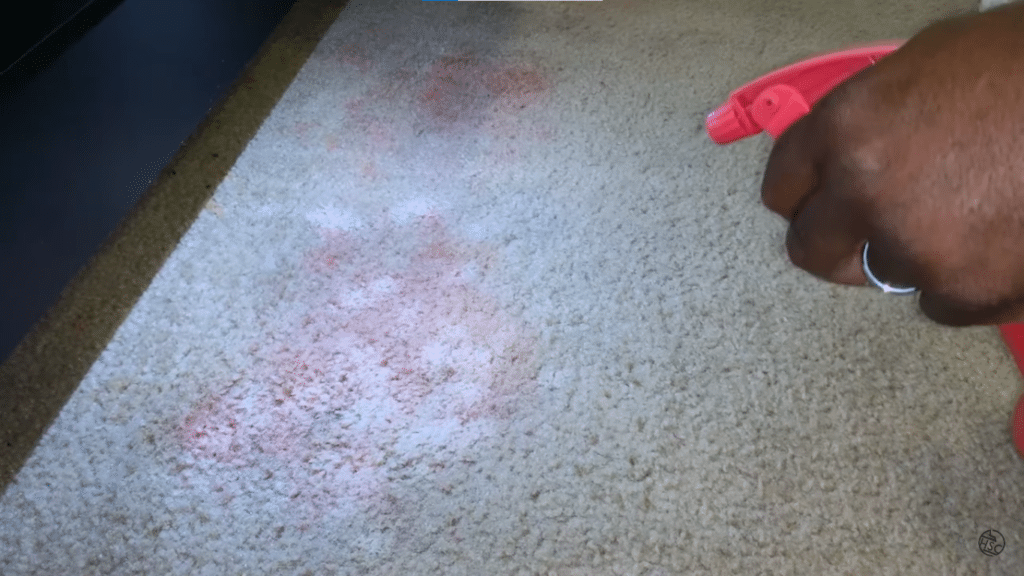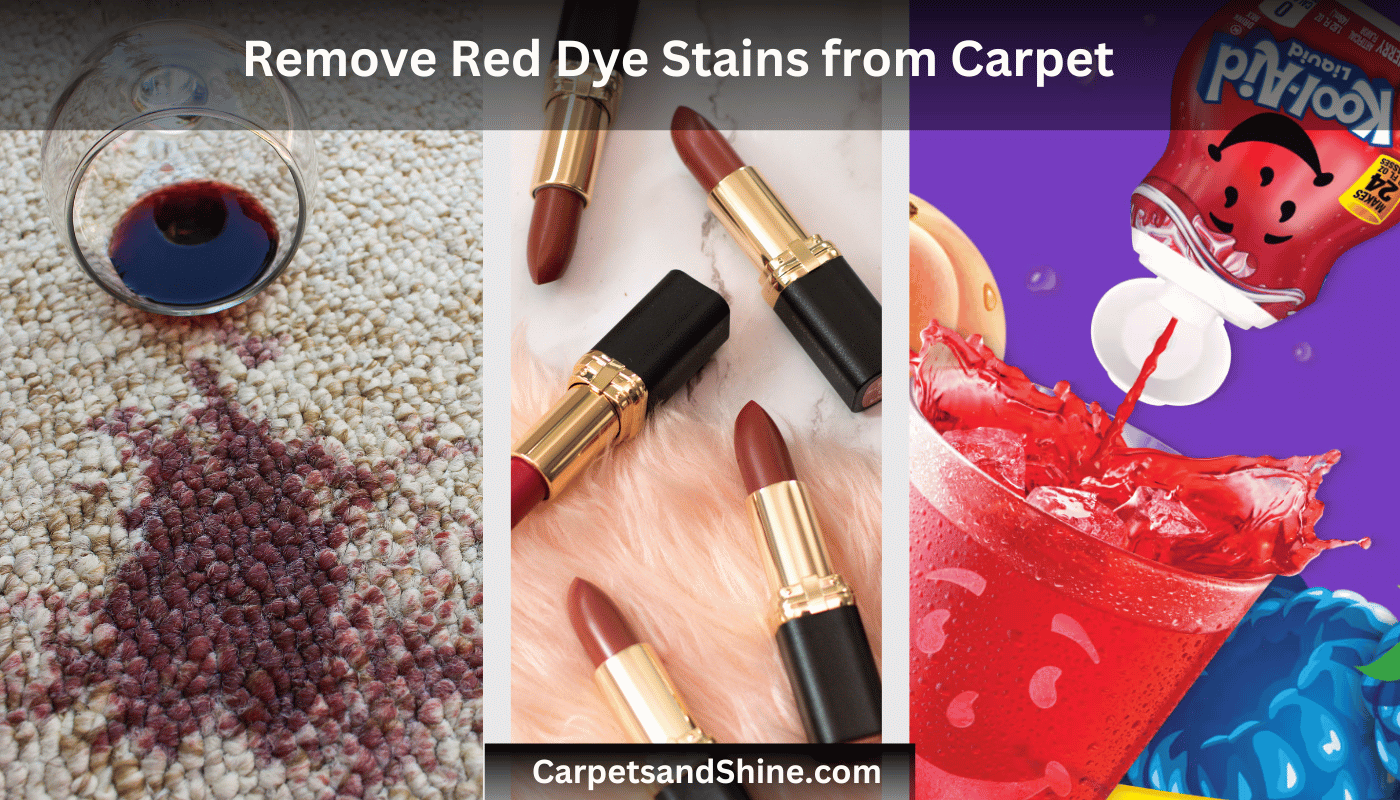Removing red stains from carpets can be a daunting task, especially when you’re dealing with notorious messes like red wine, sports drinks, Kool-Aid, and even lipsticks, fruit drinks, or sodas. These vibrant colors from various products stick deep into the carpet’s fibers, making it incredibly difficult to clean. Many consumers and landlords face this problem in both homes and businesses. You could hire a reputable company or try a DIY solution, but it’s crucial to act fast before these tough stains become permanent.
The challenge lies in the dyes used in these products, designed to adhere to your carpet. Even with Nylon or 5th generation carpets that have an invisible protective layer, the stains can still penetrate deep into the fibers. For homeowners with solution-dyed Olefin carpets, spills are easier to manage since they resist stains due to their lack of dyesites. However, for Nylon or other carpet types, using ammonia for the toughest stains like Kool-Aid or Gatorade, and following proper cleaning techniques promptly, can help restore your carpet’s original state.
Before diving into the cleaning process, it’s always a good idea to believe in hiring an expert for advanced spotting if the stains are severe. However, if you’re confident in a DIY solution, there are a few steps to follow. First, don’t panic if the red stain was spilled just a few minutes ago. Ammonia can be a secret weapon when dealing with these toughest stains like artificial Kool-Aid or Gatorade. You can also try commercial products like Wine Away or Gonzo Wine Out. These are specifically designed for red wine stains but are equally effective on other red stains, such as red dye or Kool-Aid. It’s essential to act fast before the stain becomes permanent, especially when the carpet fibers are ruined beyond repair. The patience and use of the right cleaning techniques, including treating the stain with gentle but effective solutions, will help bring your carpet back to its original state, leaving it looking new.
Immediate Action for Fresh Red Dye Stains
- Blot the Stain Immediately
When dealing with red stains on your carpet, the key is to act quickly. The first step is to grab a dry towel or paper towel and gently blot the stain—never rub, as this can make the stain larger and more difficult to remove. Keep blotting until most of the moisture is soaked up.
After that, you’ll need to rinse the carpeted area to eliminate any traces of the cleaner you used, ensuring it’s thoroughly finished. Once cleaned, cover the area with a towel to let it dry completely and to avoid dirt from being tracked over the wet carpet. Experts note that tackling the stain as fast as possible increases your chances of removing it, especially with tough red stains.
- Scrape Hardened Stains
If you discover a stain that has already dried, don’t worry—it’s still okay to clean it up. You can take a sharp knife and gently scrape away the hardened substance of the red stain, focusing on removing as much as possible.
After scraping, use a clean cloth to wipe away any small bits left behind. This process of scraping effectively removes the top layer of the stain, making the rest of the cleaning easier. If you’re hesitant to use a knife on your carpet, try using a spoon for a gentler touch. This method ensures you can clean the carpet without causing any damage.
Homemade Cleaning Solutions

Ammonia and Water Solution
Ammonia is a non-bleaching, highly alkaline cleaner that effectively breaks down tough stains without causing discoloration. If the stain is still recent, this could be all that’s necessary.
Ingredients:
- 1/4 cup of ammonia
- 2 quarts of warm water
- 1 tsp (4.9 mL) of dishwashing soap
- A clean, white cloth
- A clean dry towel
- Gloves
Steps:
- Mix 1/4 cup of ammonia with 2 quarts of warm water and 1 teaspoon of dishwashing soap in a small bowl to create a cleaning solution.
- Dip a clean, white cloth into the solution and gently dab the stain on the carpet, ensuring you avoid rubbing or scrubbing to prevent pushing the stain deeper into the fibers.
- After dabbing, use the same clean cloth to continue blotting the stain to absorb the liquid, alternating between blotting and dipping the cloth back into the solution to keep it moist.
- Once the stain begins to lift, switch to a clean dry towel to further blot and remove as much moisture as possible from the area.
- Rinse the treated area with a steam cleaner to remove any leftover residue that could cause future staining.
- Place a damp towel over the stained area and apply a hot steam iron for 20-30 seconds to help transfer the red dye to the towel.
- Repeat this process until the red dye is fully transferred to the towel.
Since ammonia can be harsh, ensure you work in a well-ventilated area and wear gloves to protect your skin. Keep ammonia away from children and pets.
Vinegar and Dish Soap Method
The Vinegar and Dish Soap Method is ideal for tackling acidic stains like red wine or fruit juice. The mild acidity of vinegar helps break down the stain, while the dish soap lifts and removes it from the carpet fibers. This method is gentle yet effective, making it a great option for fresh stains that need immediate attention.
Ingredients:
- 1 tablespoon white vinegar
- 1 tablespoon liquid dish soap
- 2 cups warm water
Steps:
- Mix 1 US tbsp (15 mL) of white vinegar, 1 US tbsp (15 mL) of liquid dishwashing soap, and 2 cups (470 mL) of warm water to create your cleaning solution.
- Dip a clean cloth into the solution and gently dab it onto the stain on the carpet, making sure to cover the whole stain.
- Grab a second clean cloth and blot the stained area to absorb the liquid and the stain itself.
- Blot the area until the stain is fully removed, and the liquid is absorbed.
Club Soda for Red Wine Stains
When dealing with red wine stains, club soda is a great option because it is weakly acidic. First, gently blot as much of the stain as possible, then pour the club soda over the entire stain. Use a clean towel to continue blotting the area, making sure to keep flushing it with more club soda until the stain is gone. Since club soda is clear, it won’t leave any residue on your carpet.
Rubbing Alcohol or Hydrogen Peroxide for Dye Stains
For stains caused by Kool Aid or red dye, carefully apply hydrogen peroxide or rubbing alcohol across the entire affected area with a gentle dabbing motion.
Method 1: Rubbing Alcohol for Dye Stains
Ingredients:
- Rubbing alcohol
- Small amounts of warm water
- Paper towels
- A clean cloth
Steps:
- Sponge the stain using a little rubbing alcohol mixed with small amounts of warm water.
- Blot the area dry with paper towels after each time you wet the stain.
- Continue until the stain is lifted, alternating between sponge and blotting to prevent pushing the stain deeper into the fibers.
Method 2: Hydrogen Peroxide for Dye Stains
Ingredients:
- 3% Hydrogen peroxide
- Paper towels
- A clean cloth
- A stack of books (or anything heavy)
Steps:
- Moisten the stained areas with 3% hydrogen peroxide and let it stand for about an hour.
- Blot the area dry, and if necessary, repeat the process until the stain is gone.
- Once the stain is gone, place paper towels over the area and weigh down the towels with a stack of books to absorb moisture over the next hour.
- If any discoloration remains, apply more hydrogen peroxide, cover with a towel, and check after 10-15 minutes. Repeat as necessary.
- You may notice some fizzing or bubbling when applying hydrogen peroxide, which indicates it’s working effectively.
Acetone for Nail Polish Stains

If you’ve accidentally spilled nail polish on the carpet, don’t worry. Quickly grab some nail polish remover to help lift the stain. Even if the polish has already dried, you can still rescue your carpet. Gently dab a bit of acetone onto the stain and let it sit for a few minutes. After that, use a clean cloth to blot the area, working carefully until the red polish is completely gone.
Besides nail polish, acetone also works well on other red stains from makeup, like eyeshadow or lipstick. Just follow the same steps—dab, wait, and blot—and watch the stain disappear.
Vinegar and Rubbing Alcohol for Juice Stains
Berry juice is one of the worst offenders when it comes to carpet stains, especially when dealing with red juice. To treat it, quickly mix 2/3 c (160 mL) of rubbing alcohol with 1 US tbsp (15 mL) of white vinegar. Take a clean cloth, dip it into the mixture, and gently dab the stain 3 to 4 times. This helps break down the stain before it can settle into the carpet.
Once you’ve dabbed the area, immediately flush it with cold water. Juice stains can be tough to remove, so it’s important to act fast. If you get to it right away, you’ll have a better chance of preventing the stain from setting into the carpet fibers.
Use Salt and a Vacuum for Small Stains
If you’re dealing with a small stain on your carpet, salt can be a helpful tool to pull moisture from the stained area. While the spot is still wet from either water or a previous cleaning solution, sprinkle a thick layer of salt over the stain. Let the area dry completely to give the salt time to absorb the moisture and the stain. Once dry, use a vacuum to remove the salt along with the stain.
You can use either sea salt or normal table salt, as both work to absorb the stain and help get it out of the carpet. Alternatively, you could try dry baking soda and scrub it into the stain with a scrub brush. Once scrubbed, simply vacuum up the residue to finish the job.
Commercial Products for Red Stains
If home remedies aren’t working, you can turn to commercial products like Wine Away or Gonzo Wine Out, which are specially made for red wine stains but also work well on other red stains like red dye or Kool Aid. Simply spray the cleaner onto the carpet, allowing it to soak in. Then, gently blot the area with a clean towel to help remove the stain completely. These commercial cleaners are easy to find at grocery stores or home goods stores.
Products like Wine Away are considered the gold standard for red stain removal and can be an effective solution if you don’t have other cleaning agents like WD-40 or ammonia on hand. With these commercial solutions, you can easily remove red stains from your carpets and dispense with other cleaning remedies.
Final Cleanup and Prevention
After treating a red dye stain on your carpet, it’s crucial to ensure the final cleanup is thorough to avoid any lingering residue. Once the stain has been treated using home remedies like vinegar, ammonia, or commercial products such as Wine Away, always follow up by rinsing the area with clean water or a steam cleaner to remove any leftover cleaning solution. This step will help prevent future staining caused by residue that might attract dirt.
To prevent red dye stains from happening again, act quickly whenever a spill occurs. Keeping simple solutions like rubbing alcohol, vinegar, and baking soda on hand can help you address spills before they set into the carpet. Additionally, consider steam cleaning your carpet yearly, especially if you have pets, to maintain cleanliness and prevent tough stains from becoming permanent.
When to hire a Professional?
You should consider hiring a professional if the stain is large, deeply set, or if home remedies and standard cleaning products like ammonia or Wine Away fail to completely remove the stain. Additionally, professional help is recommended for delicate carpets or when you need a thorough, deep clean, such as an annual steam cleaning, especially if you have pets or recurring stains that need specialized equipment.
Frequently Asked Questions(FAQs)
-
Can red dye stains be removed?
Yes, When it comes to tackling red dye stains, using oxygen-based stain removers(e.g. Wine Away) or enzyme-based laundry detergents can be highly effective. Always follow the product instructions carefully, ensuring you apply the solution directly to the stained area. To maximize results, gently scrub the stain using a soft brush or even your fingers in a circular motion. This technique helps break down the stubborn stains without damaging the carpet fibers, making it a simple yet effective way to restore your carpet.
-
How do you get dye out of carpet?
In a bowl, mix half a cup of 3% hydrogen peroxide with one tablespoon of dishwashing liquid. Dampen a sponge in the mixture, wring it out, and then apply the solution to the dye stain. Carefully blot the area, allowing the solution to work on lifting the stain. Repeat the process until the stain is completely gone.
-
Does hydrogen peroxide take color out of carpet?
Yes, hydrogen peroxide can take color out of a carpet, especially if it’s 3% hydrogen peroxide (higher percentage can damage the carpet). It works by breaking down the dye stain through oxidation. However, you should be cautious and test it in a hidden area first to ensure it doesn’t completely bleach or damage the carpet fibers.
-
How do you get food coloring out of carpet?
To remove food coloring from a carpet, mix 1 tablespoon of liquid dish soap, 1 tablespoon of white vinegar, and 2 cups of warm water. Gently dab the stained area with a white cloth soaked in the mixture, being careful not to spread the stain. Use a sponge for additional tries, continuing to dab until the food coloring is completely removed. Be sure to use a clean part of the cloth each time and avoid soaking the carpet too much.
-
Does baking soda remove colored stains from carpet?
Yes, for small stains baking soda can help remove colored stains from carpet. It acts as a natural cleaning agent by absorbing moisture and lifting stains when left on the stained area for a few hours. To use it, sprinkle 3 to 4 tablespoons of baking soda on the stain, let it sit for 4 to 6 hours, and then blot with a clean, damp rag before vacuuming. This method is especially effective for lighter stains but may require repetition for tougher stains.

